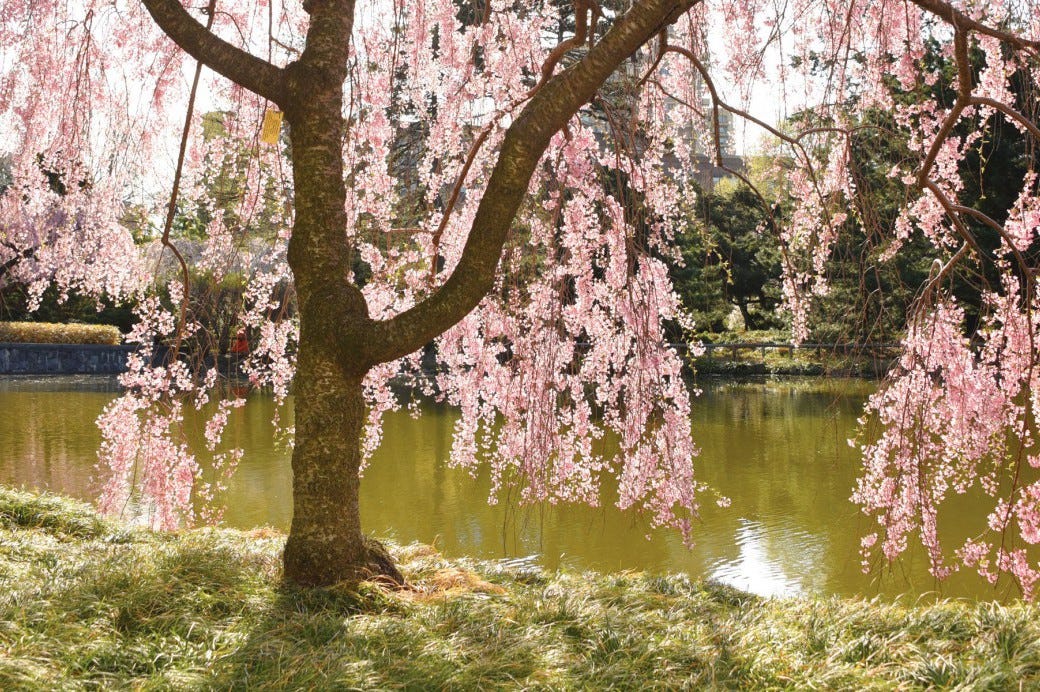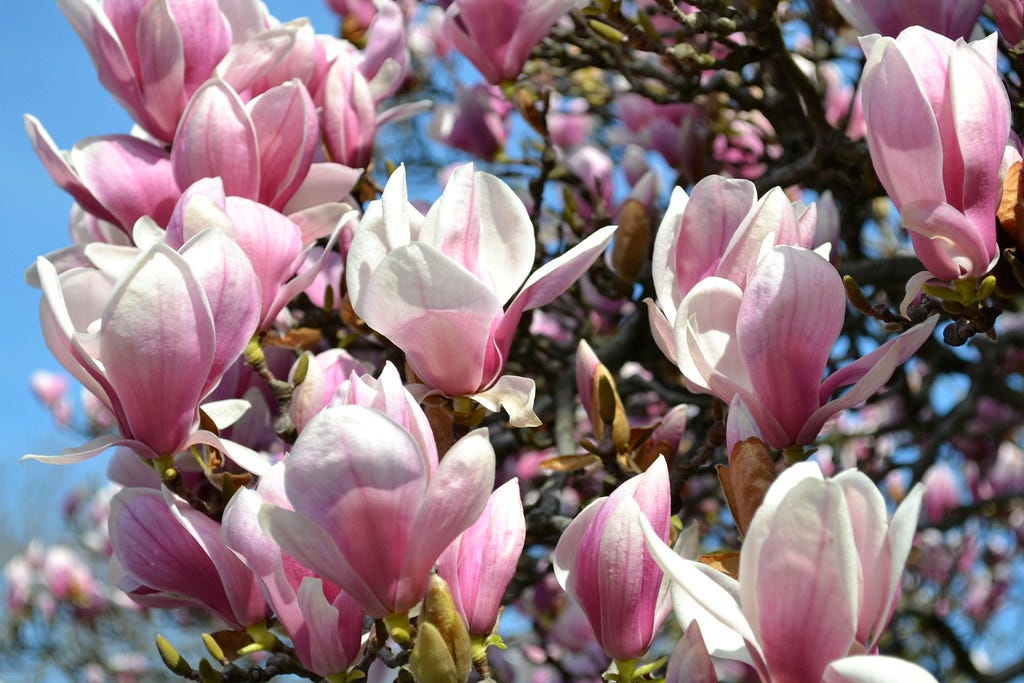Some Lessons from the Trees
New York's flowering trees have reached "peak bloom." But are they trying to tell us something?

The Weeping Higan Cherry tree at the Brooklyn Botanical Garden.
When I crossed the Manhattan Bridge on my run last week, a tree stopped me dead in my tracks. It was one of many cherry blossoms lining a small stretch of the Bowery, but this one had been impeded by scaffolding for construction. Its flowers bloomed nonetheless, pressing their pillowy pink petals up against the metal platform, their branches stretching out from underneath the sheet metal and reaching towards the sunlight. It looked as though the blossoms were going to break through the manmade machinery. I laughed as I walked underneath it, amused.
On my run back to Brooklyn, I suddenly became aware of flowering trees everywhere—pretty, small white petals with yellow centers on a ten-foot specimen on Adams Street (a crabapple), gigantic white petals with pink-purple stripes down their centers seen dazzling in a tree-lined plot on Myrtle (magnolias). I learned how to identify them when I spoke to Ronnit Bendavid-Val, the director of horticulture at Brooklyn Botanical Garden. “Spring is when you feel like things are just waking up all around you,” she says. This will be my tenth spring in New York and yet, it feels like the first one where I’m actually awake, too.
Quarantine has something to do with this—I’ve quite literally never walked around my neighborhood with the same frequency or attention to detail as I do now. One day, I was so bored that I actually got excited to watch the rain out my window. To be fair, though, I was starting to notice the trees around me well before social distancing. In January, I finished The Overstory by Richard Powers, a book whose many characters’ lives revolved around the trees planted in their yards or the forests nearby. In turn, I learned more than I bargained for. For example, the fact “that trees could communicate, over the air and through their roots,” as Powers writes. Or, “that a tree learns to save water.” Or, “that trees feed their young,” and “send out signals to wasps to come and save them from attacks.”
I did not know that trees were so intelligent. It was this I had in mind when I saw the cherry blossom, defiantly blooming despite being caged by construction. I took out my headphones just to look up and stayed there for a few minutes, marveling at the flowers’ petals. “Trees know when we are close by,” Powers says. “The chemistry of their roots and the perfumes of their leaves pump out change when we’re near...when you feel good after a walk in the woods, it may be that certain species are bribing you.” If this is true, I was perfectly happy to become bewitched.
Trees are a helpful metaphor in our current moment, when we are (for once) confined to one place and forced to either buckle under pressure or learn how to grow. This occurred to me when, during another punishing at-home yoga class, I lost my balance during “tree pose.” It is remarkably hard to stand completely still and find one’s balance. But stillness is just one of many lessons we can learn from the trees. In many ways, we are their exact opposites. We are subject to the whims of punishing schedules, while they know only the seasons. We retreat inside when the weather gets too cold or too hot; they withstand the elements. We relish the prizes of instant gratification—meanwhile, a tree can take decades to grow. We bemoan inconveniences and changes to our daily lives; they find ways to simply peek out from under our scaffolding and bloom anyway. There’s a resilience to trees that, once you know how to look at them, somehow feels a lot like wisdom. Maybe that’s because they’ve been around for some 370 million years, while we’ve only existed for 200,000. (And the jury’s still out on whether or not we’ll make it to 200,001.)
If you’ve walked around New York lately, maybe you also have been delighted to encounter pink, flowering trees on your daily walk. It’s likely that these are cherry blossoms—the trees that are the crown jewels of the Brooklyn Botanical Garden’s programming. Every spring since 1982, the Garden has hosted “Sakura Matsuri,” an annual cherry blossom festival. Inside their gates, 26 “species and cultivars” of “cherries” bloom at various points throughout the season. (I learned recently that some cherry blossoms do, in fact, grow cherries, but they are too bitter for the human tongue. Instead, the birds of the Botanical Garden enjoy a modest feast of them.) Meanwhile, thousands of visitors embark upon “Cherry Esplanade” to see explosions of pink rising like mountains along the Garden’s lawn. Each spring, the experts there usually wait for one specific variety—Prunus ‘Okame’—to swell and slowly reveal its petals. Then, over a span of weeks, the others will follow, sometimes lasting late into May.

The Kanzan cherry blossom. Photo via Brooklyn Botanical Garden.
The most beloved of the cherries in New York, Ronnit says, are the Kanzan—a particularly demonstrative cultivar that carries up to 28 petals on each bloom. You can find the Kanzan lining the vast, open lawn of the Botanical Garden, like big, pink fireworks. They are a favorite among the experts there not just for their beauty, but also for their survival skills: Cherry blossoms typically have a relatively short lifespan compared to that of other trees, an average of 30 years. The Kanzan that decorate Cherry Walk, on the other hand, are among the oldest trees in all of the garden, dating back to 1921, making them nearly 100 years old. There’s another lesson in wisdom we could stand to learn from the trees: There’s beauty in age.
It’s hard to think of a tree that embodies this notion better than the Magnolia—ancient plants that have existed on the planet for at least 95 million years. You may associate magnolias with the South, where the grandiflora reigns with opulent, white petals perfuming the air, but right in Brooklyn, the saucer magnolia is blooming all over, its resplendent, pink-and-white petals spreading over their branches and onto our sidewalks. It’s said that Andrew Jackson planted a magnolia tree near the South Portico of the White House over 200 years ago—a tribute to his wife, Rachel, who died shortly after he won a rather tumultuous election. After Rachel’s death, President Jackson requested a sprout from her garden be brought to the capital, where it was planted in her memory. The tree grew to become a beloved staple of White House imagery, earning its spot on earlier versions of the $20 bill that bears Jackson’s face. It’s said that Hoover liked to dine under its shade, the Obamas gifted its seedlings, and Laura Bush commissioned a china set bearing its likeness. Visitors of the White House and the press corps also gathered underneath the petals of the magnolia tree, since it offered a welcome respite from the sun. Unfortunately, the famous tree suffered a “gash” in the ‘40s, and had to be propped up by poles to keep it upright. When it eventually became clear that a gust of wind from President Trump’s helicopter could knock the tree over, First Lady Melania Trump ordered its removal—200 years of American history leaving the garden by its roots. Luckily, the famous magnolia’s offspring are being cultivated in a greenhouse, apparently awaiting sunnier days before eventually bestowing their gifts upon the capital once again. Another lesson from the trees: What was lost can be cultivated once again, so long as we’re willing to take the time and care to do so.

Magnolia x soulangiana, or saucer magnolia, blooming at Brooklyn Botanical Garden.
Oddly enough, another type of flowering tree that’s currently gracing New York with its color was also beloved by an American president. George Washington reportedly wrote in his diary “on many occasions” about the beauty of the Eastern redbud. He was so taken with its majesty that he transplanted seedlings in his own garden, framing them with dogwoods and small flowering shrubs. The redbud is typically of modest height, with thin branches that explode outwards like arms outstretched, beckoning the butterflies that like to perch upon them. Today, many Eastern redbuds stand in the garden at Washington’s historic home in Mount Vernon. “The flowers come directly out of the trunk, and they look like tiny, pink or purple dots with no leaves at all,” Ronnit says. “The flowers don’t open in this really blatant way that the cherries do, but it’s still a gorgeous little tree.” Another helpful lesson on Beauty here, too: Sometimes, it’s best found in the subtleties.

The Eastern Redbud at Mount Vernon.
Learning the origins stories of these trees and seeing them in their intended habitats, it’s hard to imagine how anything of such beauty and complexity could thrive in a city like New York, getting whacked by trucks, pissed on by dogs, and polluted by, well, all of us. “It’s a tough place for trees, especially out on the sidewalks,” Ronnit says. She explains that the tiny, square plots we see reserved for trees on our sidewalks are called “tree pits.” The major problem with these modest pits is that trees’ roots are quite expansive, growing far beneath the earth in order to grow nice, tall, and sturdy. Many of New York’s “street trees” have been unable to stretch below the sidewalk, since earlier city development wasn’t built with tree roots in mind. “After a storm, if you see a tree knocked over with exposed roots, it’s because that tree was restricted into a little square box,” Ronnit says. Luckily, the Parks Department has since intervened, clearing underneath the ground for our newer trees to live long and healthy lives. Another convenient lesson from the trees: You can’t prosper if you’re forced to shrink yourself.
Sometimes, I fear it’s too late for all the other lessons the trees have for us. There’s the one about respecting the environment, since trees create better air quality where they’re planted. There’s also the one about sharing your privileges, since trees’ branches, nooks, and crannies are home to countless critters, insects, and birds. And then there’s the one about our incredible and awe-inspiring interconnectedness—how deforestation directly contributes to climate change and, thus, natural disaster.
Maybe that’s why it feels only fitting that I write this just after we’ve passed “peak bloom” for the flowering trees in New York City. By the time I took notice and felt moved enough by our trees, the bloom was already nearing its finale. Many of the cherry blossoms will have relieved themselves of their laborious beauty by now, raining petals onto our streets and sidewalks, leaving behind branches filled with nothing but green. The pink confetti lining our streets means that Spring has officially arrived, and Summer is well on its way—despite the fact that the rest of us are still stuck inside. A final lesson from our flowering trees, this one a benevolent warning: We can be humbled, scared, and forced to stop everything we once knew. The trees, on the other hand, stop for no one.




The beauty is astounding - trees are definitely telling us to stop and appreciate the awesomeness of nature and that life, like the tree, will spring forth once again into full bloom eventually